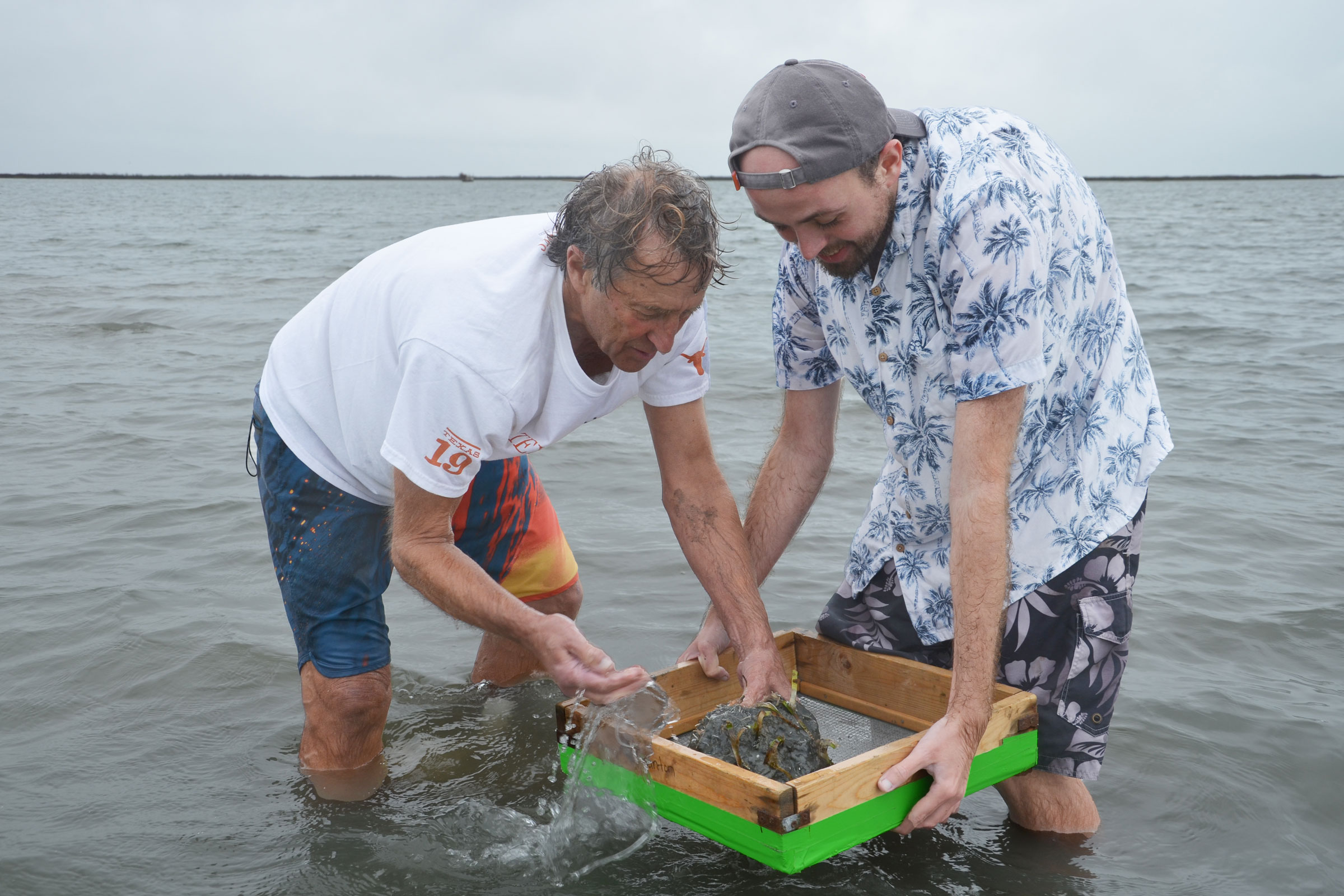Heartbeat of the Estuary
Philip Souza’s research is focused on the sounds that fish along the Texas Gulf Coast make to attract mates or defend territory.
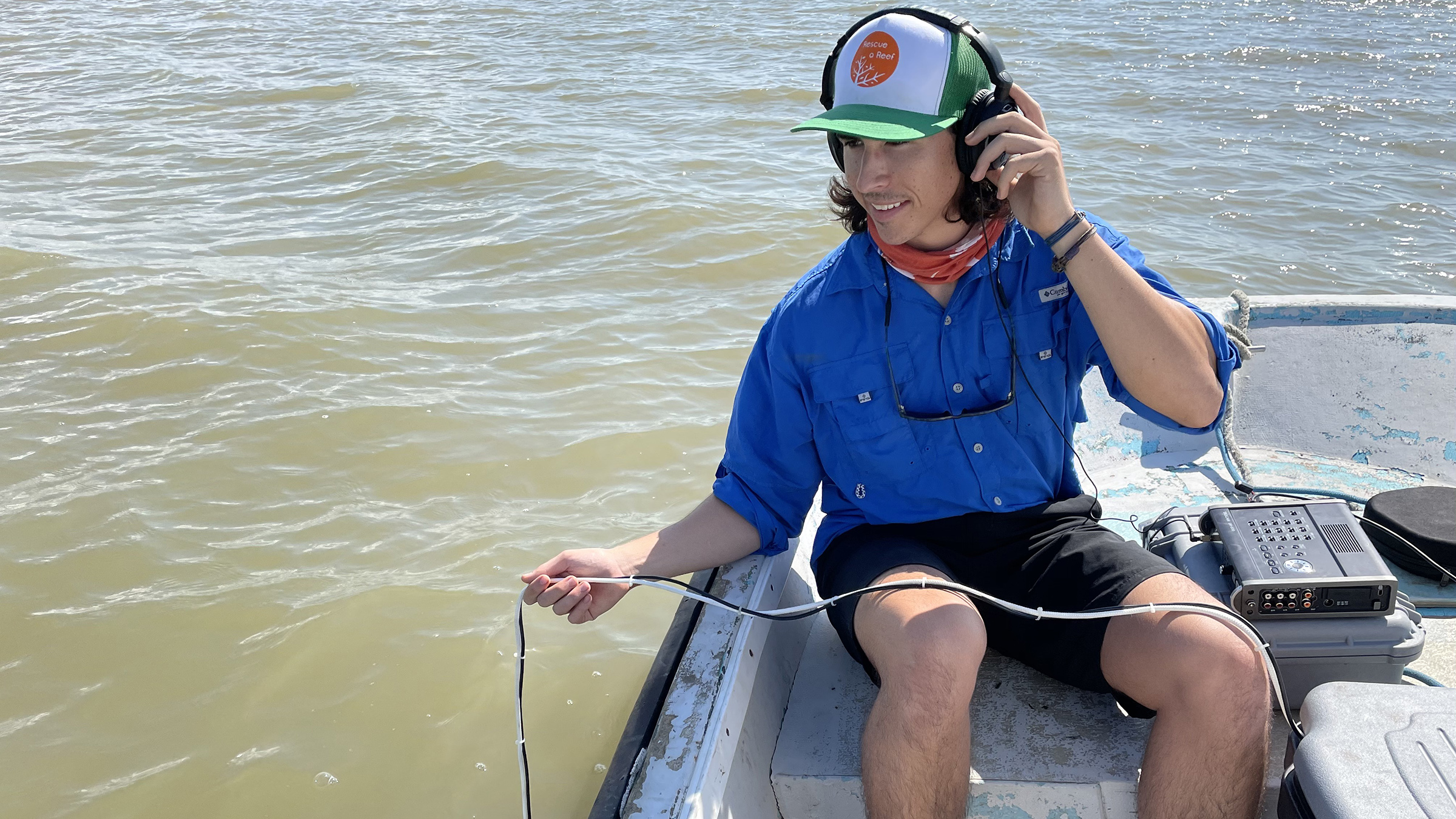
Philip Souza, a graduate student at UT Austin's Marine Science Institute, eavesdrops on fish in the Mission-Aransas Estuary.
On today’s show we talk with Philip Souza, a Ph.D. student in the lab of Simon Brandl at the Marine Science Institute, and a Stengl-Wyer fellow. His research is focused on the sounds that fish along the Texas Gulf Coast make to attract mates or defend territory. He works in the Mission-Aransas Estuary near Port Aransas, whose oyster reefs and other habitats support rich communities of fish, many of which have a big impact on the Texas economy — including spotted sea trout, catfish, red drum and black drum. He’s developing ways to continuously record sound in the water to monitor the health of the ecosystem. As fate would have it, two years ago, his approach was put to the test.
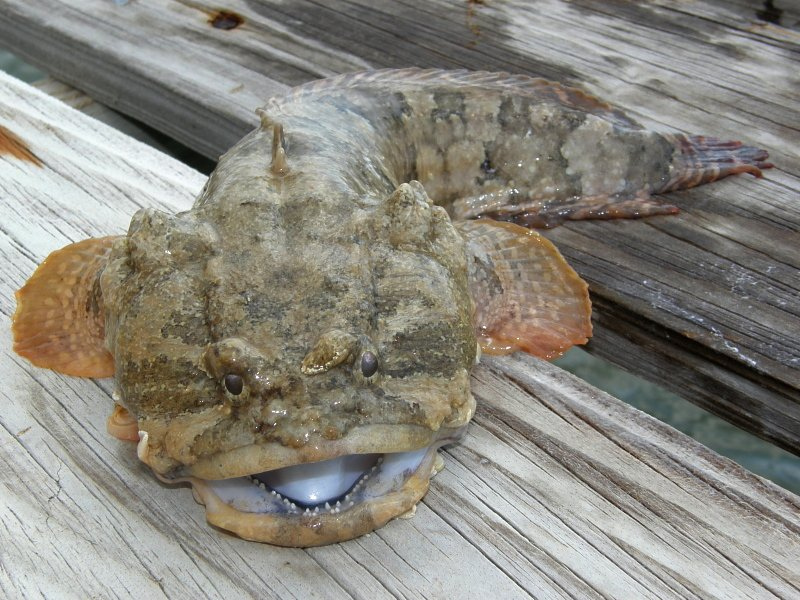
Gulf toadfish. Credit: John Williams (CC BY-NC).
Show Notes
Read a Q&A with Philip Souza
See a map of the Mission-Aransas Estuary
Learn more about the Mission-Aransas National Estuarine Research Reserve
Our theme music was composed by Charlie Harper
Other music for today’s show was produced by: Podington Bear
TRANSCRIPT
MA: Philip Souza is a connoisseur of fish sounds.
PS: This — you’re in for a treat — this is my personal favorite — the Gulf toadfish.
[SFX: Gulf toadfish]
MA: Let’s hear that again …
[SFX: Gulf toadfish]
PS: It does have a, I guess, a reputation as an uglier fish, but I want it on record that I think they’re very cute animals. I'm very, very fond of these little critters.
MA: A tall, energetic Ph.D. student wearing a baseball cap, Souza studies one of the most productive fisheries in the U.S., collecting the sounds that fish in the Texas Gulf Coast make to attract mates or defend territory.
PS: This is a spotted sea trout. So this is a species that’s extremely recreationally important, so very important to the local economy.
[SFX: spotted sea trout individual]
MA: Cataloging these sounds can be useful in efforts to monitor the health of the ecosystem.
PS: This is a hardhead catfish
[SFX: hardhead catfish individual]
MA: So I’m hearing two things. I’m hearing a little crackling sound and then I’m hearing, like a, almost like a woodpecker or something, or like somebody's hammering a nail or something.
PS: So that snap crackle and pop is the snapping shrimp. That's just constantly going, like you just poured milk into your Rice Krispies cereal. And then that sort of knocking sound that you referenced is the hardhead catfish. I’ve heard this sound compared to the sound of percolating coffee, which I think is really funny.
MA: Oh, interesting. Yeah, I can hear that.
MA: I’m Marc Airhart for Point of Discovery. I’m at the University of Texas Marine Science Institute in Port Aransas with Philip Souza to talk about a day a couple of years ago when the nearby estuary — which usually hosts a rich symphony of sound — went silent.
PS: And it’s a little bit scary. You know, if you were to walk into a forest, you know, and you hear all these sounds around you, birds producing sound, insects producing sound, and all of a sudden it went quiet,] you’d be like, “Yikes, like, maybe I should get out of here!” Like, that would be alarming.
MA: Every spring, in the Mission-Aransas Estuary near Port Aransas, on most days, many of the mature male fish — the spotted sea trout, silver perch, black drum and so on — make mating calls. Every evening, they grunt, knock, and purr, hoping to catch the attention of female fish. Souza shows me a graph with underwater sound levels plotted out over time. Like clockwork, you can see the sound levels go UP every evening as the fish chorus— and back DOWN during the daytime when the fish stop calling.
PS: So I like to consider it sort of like a heartbeat of the estuary. You have daily and seasonal rhythms that are very predictable. And that’s what you would expect from a healthy biological soundscape in our estuary, from really February through the fall, is these nice daily peaks.
MA: Souza has been putting special underwater microphones, called hydrophones, out in the estuary for a few years now, gathering continuous baseline recordings of the natural fish spawning sounds. He showed me what you can hear when a large group of spotted sea trout are spawning.
[SFX: evening chorus of spotted sea trout]
PS: that’s just a steady signal from, you know, what’s presumably hundreds of spotted seatrout aggregating, to spawn in this area …
MA: And then there’s the silver perch. He warns me it’s going to be loud and annoying.
[SFX: evening chorus of silver perch]
PS: So that’s [MA: Wow!] yeah, that’s the really annoying fish that I was referring to earlier, the silver perch. It’s really loud. And it’s, to me it’s like nails on a chalkboard, listening to it. A lot of times it’ll sound like heavy rain or hail falling on a tin roof.
MA: But if you’re a lady fish, that’s pretty awesome.
PS: Exactly. I’m sure they’re really excited about that.
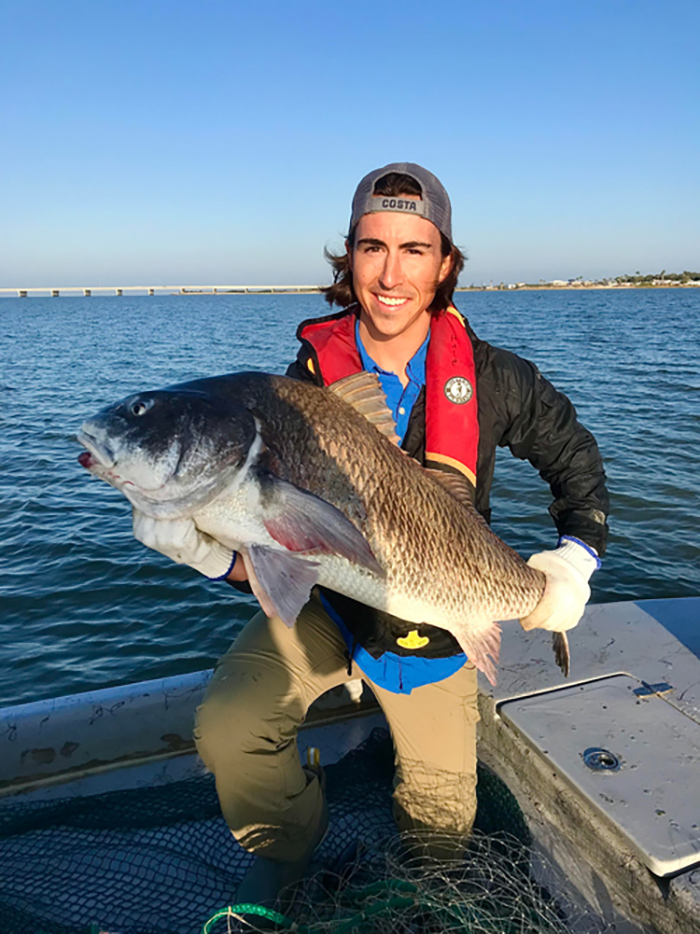
Philip Souza holding a black drum (Pogonias cromis), one of the sound-producing fishes found in Texas estuaries.
MA: Those sounds may be annoying to us, but they mean the fish are interacting as thriving fish do. And that means a healthy ecosystem. The oyster reefs and other habitats in the Mission-Aransas Estuary support rich communities of fish, many of which have a big impact on the Texas economy — including spotted sea trout, catfish, red drum and black drum. So there’s a lot of interest in protecting this ecosystem. But Souza says it’s really hard to get a handle on which species of fish are in a given area at a given time — how many of each kind there are — and what they’re up to.
PS: I like to compare swimming in our estuary to swimming in a vat of chocolate milk at times. So, on a good day, you might have, you know, half a foot of visibility, but most days you can only see maybe a couple inches in front of your face. So that really limits you as far as what types of techniques you can use to monitor the estuary and the communities that live inside. You can’t jump in with snorkel or dive gear and simply look around to see what’s there.
MA: Because of the limited visibility, to keep tabs on these fisheries, marine biologists typically sample fish with big nets that kill or injure the very fish they’re interested in. That can run counter to conservation goals — plus it is very labor intensive, and provides only occasional snapshots of what’s out there. So Souza is developing ways to continuously record sound in the water that can provide a clearer picture of what’s going on. He hopes this method can one day supplement — and maybe even partially replace — other methods of directly surveying fish populations. As fate would have it, two years ago, his approach was put to the test.
MA: In early May 2021, some heavy rain sent a lot of freshwater surging down two rivers and pouring into the Mission-Aransas estuary. [SFX: rain] The estuary is usually pretty salty – closer to the salinity of ocean water than freshwater. That first big surge of freshwater caused some fish that can’t tolerate low salinity, like silver perch, to stop calling. Then in July, a second, bigger freshwater pulse came into the estuary — in some places, the salinity dropped so much that the water essentially became fresh. Remember those loud calls we heard earlier, when the fish were happy and healthy? Now Souza showed me what it sounded like underwater after that second pulse came and the salinity crashed.
PS: And we’ve got the volume jacked all the way up here and you’re probably still not going to hear much of anything.
[SFX: sound after freshwater disturbance]
MA: All you can really hear are waves crashing and some random noise.
MA: Remember his heartbeat analogy — those normal peaks of sound every evening when the male fish are calling out for mates? Now, following this freshwater disturbance, it was like that heartbeat flatlined.
PS: And all of a sudden, those daily peaks, those clean daily peaks, disappear and you get that chaotic signal again.
MA: Or to use his other analogy, it was like the forest went silent.
PS: You’d be like, “Yikes, like, maybe I should get out of here!”
MA: So what happened to the fish and other critters when the salinity crashed?
PS: So if you have, you know, dramatic drops in salinity, that can cause some physiological challenges for the fish, they have trouble maintaining the proportions of salts in their body, salts to water. But my feeling is that they’re just completely moving out of the area. These are very mobile fish species, they’re very capable of moving out of the area.
MA: In addition to the hydrophones, Souza had some trays sitting on the bottom of the estuary at a restored oyster reef as part of another experiment. In those trays, the biomass of little fish and shrimp and so on dramatically dropped following these freshwater pulses. These smaller, less-mobile species couldn’t move as far or as fast as the big fish, so the salinity crash probably had a big, short-term impact on them — some probably died, some were just stressed. The good news is those small critters mostly recovered their normal abundance and biomass in about two and a half months. But over the long term, those big, mobile fish — even though they could escape —might have had the worst overall impact. After all, the disturbance came right at the height of spawning season.
PS: It is a little bit worrisome that such a large portion of the estuary, about half of the estuary experienced that interruption to the spawning behavior, just because of this freshwater inflow event. And for many of the species in Copano West, they didn’t return to that area for spawning for that entire spawning season. Obviously spawning is a very important part of their life history. And without spawning, you’re not producing the next generation of this fish, that’s very important to maintain the populations.
MA: In the future, the kind of dramatic change in the soundscape that Souza picked up could be a kind of early warning that something has changed that scientists and fisheries managers might need to go check out. He shows me the graphs of sound intensity for the following year and I can see, once again that beautiful, ticking of the estuary’s heartbeat. He says this experience — and the other research he’s conducting — show that sound can be a powerful tool for keeping a finger on the pulse of an underwater ecosystem.
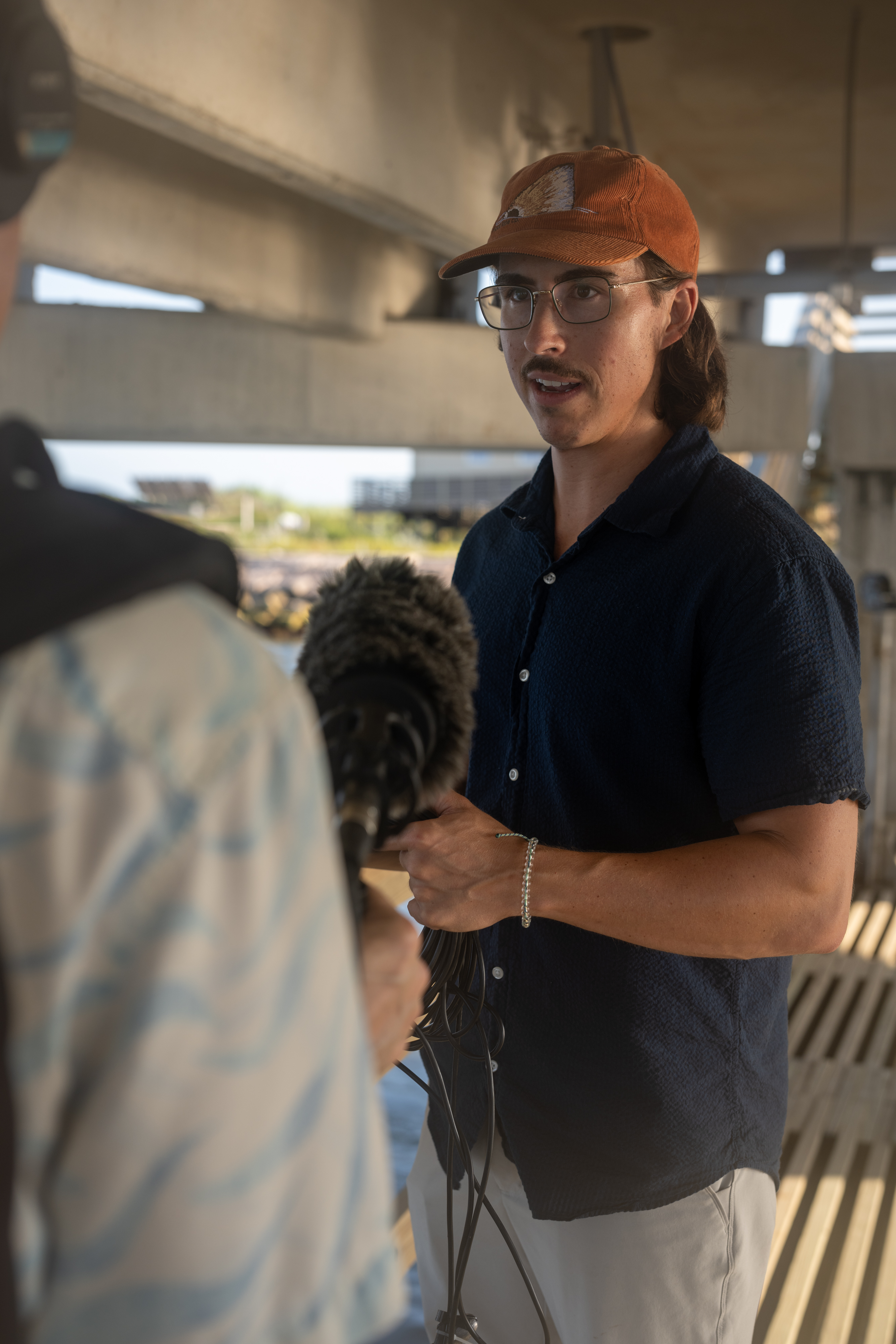
Philip Souza being interviewed for this podcast. Credit: Nolan Zunk.
MA: It’s not just big, dramatic disturbances like that freshwater pulse that Souza can pick up with his hydrophones. It’s also subtle changes over weeks, months and years — the rise and fall of different underwater species across the landscape. To measure those kinds of changes, he needs ways to correlate specific sounds with what’s going on in the water.
MA: In a recent study, he compared live sound recordings taken at the same time as a traditional survey using nets to catch sound-producing fish in the Mission-Aransas Estuary.
PS: And one of the findings that we had is that there’s a positive relationship between sound levels and how many fish are in the area. So once you have that relationship, you know, you can sort of monitor target locations through time. And you know, if it’s louder at one point, that would suggest that there’s a higher relative abundance of fishes in that area.
MA: And sound can tell you more than just how many fish are there. Just like bird calls, to the trained ear, you can pick out each individual fish species by the different kinds of calls they make.
PS: It’s very easy to go and listen to sound files, identify different types of vocalizations. Some of which are, you know, well-defined, we can identify what species are making those vocalizations.
MA: He relies on a set of global fish sound libraries to help identify each species — kind of like those cell phone apps that can recognize birds by their calls. For fish sounds that haven’t been well documented, he’s built a kind of “fish recording studio.” In a small closet, he covers a fish tank with a soundproof box to try and capture the sounds of some of the smaller, quieter fish in the area.
PS: So it's really a matter of trying to get them in a very quiet space with some sensitive equipment and see if we can collect some sounds that may be only traveling a very short distance.
MA: With each new species he captures …
[SFX: Gulf toadfish]
MA: … the global library of fish sounds becomes just a little bit richer.
MA: That’s our show. Point of Discovery is a production of The University of Texas at Austin’s College of Natural Sciences and is a part of the Texas Podcast Network. The opinions expressed in this podcast represent the views of the hosts and guests, and not of The University of Texas at Austin.
MA: To see pictures of the Gulf Toadfish — Souza’s fish recording studio — and more — head on over to our website at pointofdiscovery.org.
MA: Our theme music was composed by Charlie Harper. If you like our show, be sure and tell your friends. We’re available wherever you get your podcasts, including Apple Podcasts, Google Podcasts and Spotify. Our senior producer is Christine Sinatra. Thanks for listening!
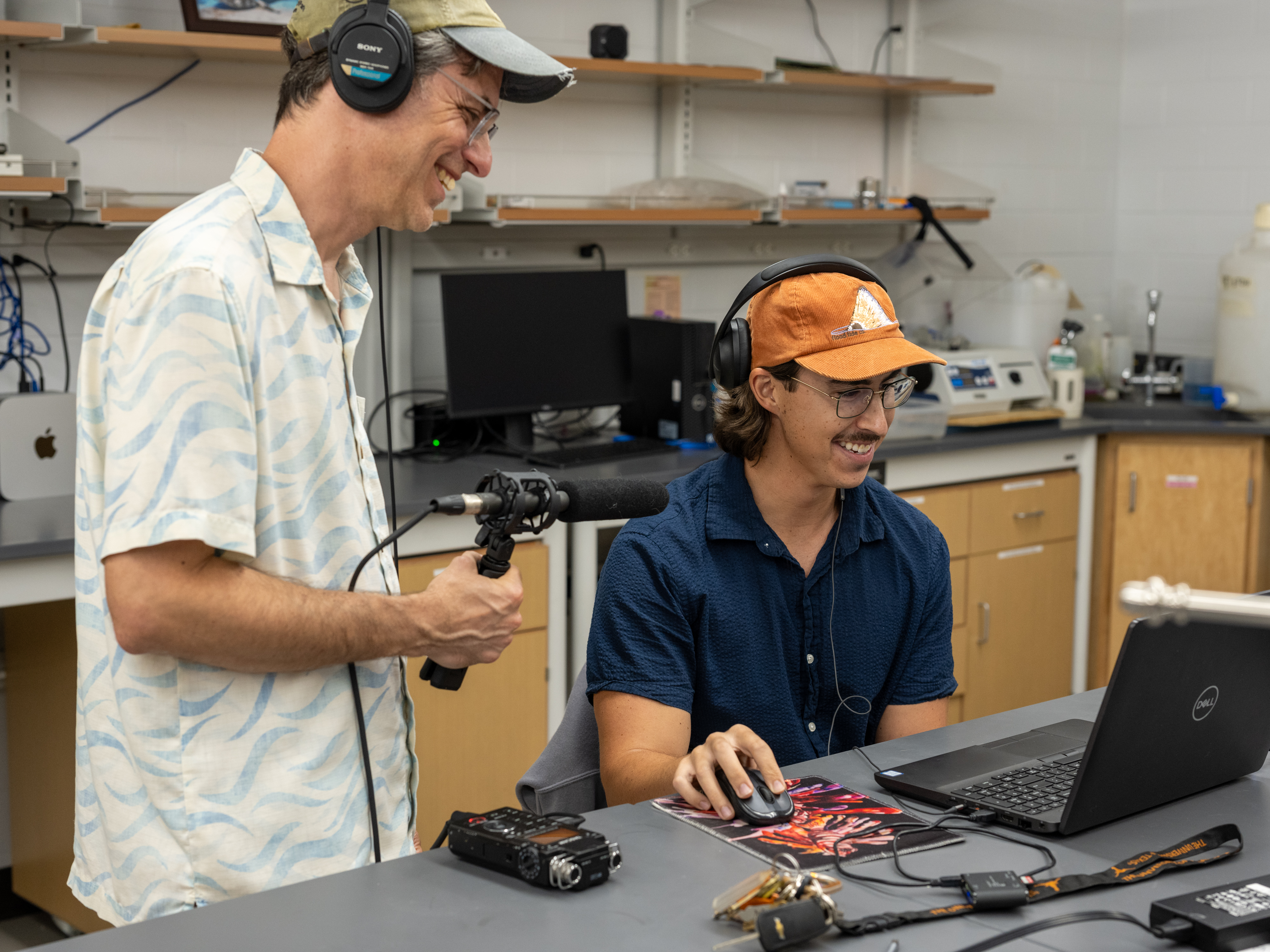
Marc Airhart interviews graduate student Philip Souza at UT Austin's Marine Science Institute. Credit: Nolan Zunk.
About Point of Discovery
Point of Discovery is a production of the University of Texas at Austin's College of Natural Sciences and is a part of the Texas Podcast Network. The opinions expressed in this podcast represent the views of the hosts and guests, and not of The University of Texas at Austin. You can listen via Apple Podcasts, Spotify, RSS, Amazon Podcasts, and more. Questions or comments about this episode or our series in general? Email Marc Airhart.



